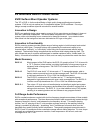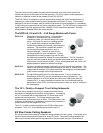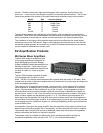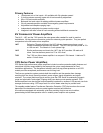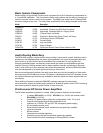
preference? Getting this kind of information at the beginning will help to avoid confusion and
delays at the installation stage.
Just as important as the human factors are the construction details of the site. How are the walls
and ceilings constructed? What kinds of mounting surfaces will be encountered? Is the drop
ceiling a lay-in type, or tongue-and-groove? Where must cabling be routed, and how accessible
are those spaces? Do partition walls or bearing members extend above the drop ceiling, where
they may obstruct cable runs? Is conduit or plenum cable required? All of these factors directly
affect the price quote and the actual task of installation.
A key decision early on in evaluating the equipment requirements is what type of infrastructure
the system should have. The decision will determine if a mixer amplifier is used for the
installation or if the ProAnnounce digital matrix routing system is used. The key questions to ask
consist of the following:
1. Are there more than 2 independent audio programs running simultaneously?
2. Are “zone specific” independent remote controls required for volume levels in each zone?
3. Is the ability to remotely switch program sources for a particular zone required in more than
one zone?
4. Do voice pages and announcements need to be restricted to certain areas of the building?
5. Is remote off site control of the system a required feature?
6. Are the power requirements for the system greater than 600 watts?
If the answer to any one of these questions is yes there is a good possibility that the
ProAnnounce digital matrix infrastructure is required. The additional cost for this system however
is not that great. The typical premium for a ProAnnounce routing system is less than $1,200 for
most installations over that of a “discrete” system design. In many cases there is no other viable
solution to accomplish what the client wants.
Step 2 – Determine the Acoustic Requirements
When the basic infrastructure is established then a system acoustic layout can be done. This
would consist of the following basic steps:
• Establishing required coverage areas
• Setting the acoustic volume (SPL) levels desired
• Establishing any esthetic or design requirements for the speakers.
• Estimating background noise levels for each zone.
• Determining the program material content to be run through each zone.
All this is done while taking into account the expectations of the client and the environment in
which the system will be run. Is it a loud sports bar or a quiet elegant restaurant? Or is it a large
open area of a hotel lobby and ballroom? Any of these needs can sway the final equipment
selections.
At this point you need to determine the number of speaker appliances needed for the installation.
This can be done using computer design tools such as the free EV Excel speaker calculator when
using ceiling speakers or EASE which is a full scale acoustic modeling package.
Step 3 – Conduct a Preliminary Layout and “Walk Through”
The third step is to assemble the system design on paper and review the signal paths, amplifier
power requirements and establish the basic functionality of the overall system design. This can
be done with the aid of the ProAnnounce designer software if a pro announce based system is
being employed. If a simpler system is used then often a basic charting package such as Visio is
adequate to lay out the system.
ElectroVoice/Dynacord BGM Guide Page 15



